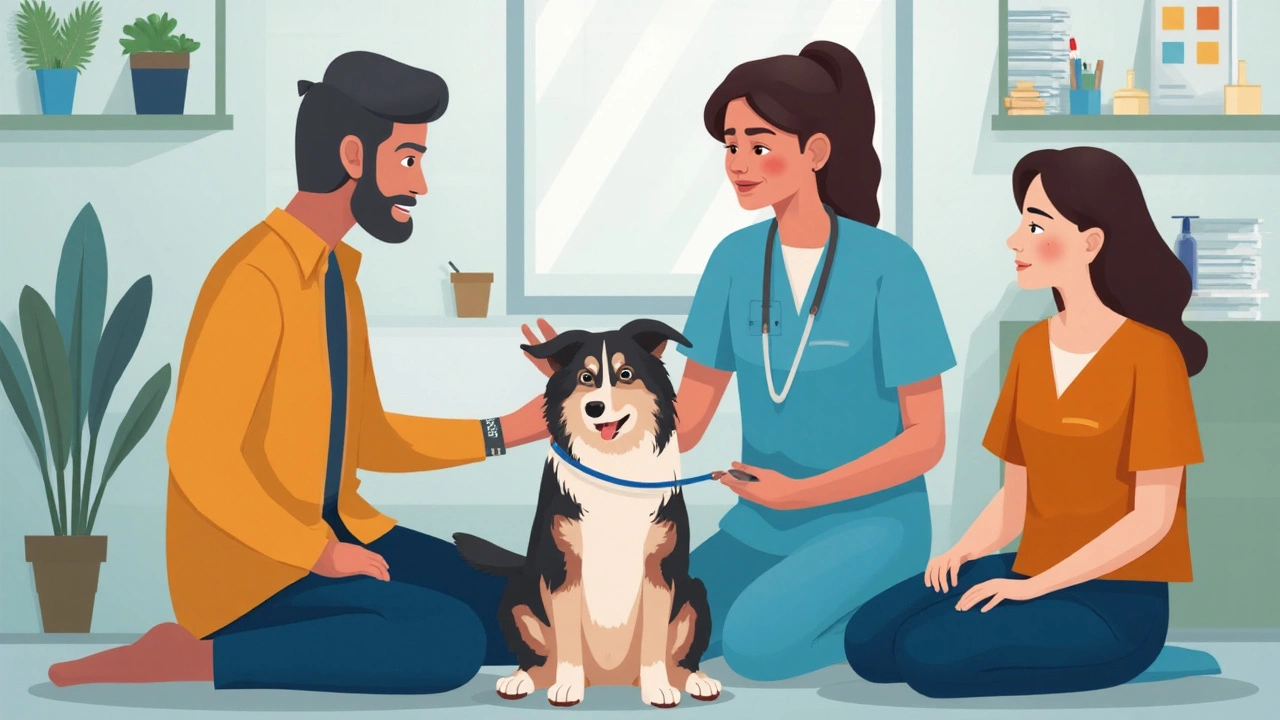Picture this: you're about to leave for work, and your pup starts pacing, drooling, maybe even whimpering by the door. It breaks your heart every time. The world is packed with solutions for stressed-out dogs, and there’s one product that flies off pet store shelves—dog calming collars. Walk down any pet aisle, you'll see rows of them with words like "soothing pheromones“ and "proven calm." But what’s the real deal? Do dog calming collars truly work, or are we chasing marketing hype? Grab a coffee (or something stronger, depending on how your own dog has slept), and buckle in for a dive into the science, the stories, and what actually helps our best furry friends settle down.
How Calming Collars Are Supposed to Work
These collars aren’t just another dog fashion trend—they’re marketed as wearable stress relief. The core idea: calming collars release either natural pheromones (think synthetic versions of the vibe a mother dog sends to her puppies) or blends of botanicals such as lavender and chamomile. Pheromone collars, especially brands like Adaptil, claim to copy dog-appeasing pheromones (DAP). In nature, these pheromones help mother dogs keep their wiggly puppies chill. The collar, activated by your dog's natural body heat, releases a low, steady dose your pup can detect. The theory is, it signals "hey, you’re safe, no need to freak out." Some collars swap out pheromones for essential oils, aiming for similar "Zen garden" effects in a less scientifically heavy-handed way.
Let’s put some stats on the table, literally:
| Brand | Active Ingredient | Duration | Claimed Effectiveness (%) |
|---|---|---|---|
| Adaptil | Synthetic DAP | 30 days | Up to 90% dogs calmer in clinical setting |
| Sentry | Lavender/Chamomile | 30 days | Reduced stress behaviors in 70% homes, per user review data |
| Calm Paws | Essential oils blend | 30 days | Mixed, depends on sensitivity |
Clearly, the marketing is bold. But before you run out and buy five, let’s unpack how these ingredients interact with real, actual dog brains. Pheromones for dog stress have been studied for two decades. A 2018 review in the Journal of Veterinary Behavior found pheromone collars slightly better than placebo for noise phobia and mild anxiety, especially in situations like moving, fireworks, or kennel boarding. On the flip side, essential oil collars have almost no solid science—aromatherapy helps some dogs relax, but reactions run the gamut from "snooze" to "sniffle-fest allergies." Still, thousands of dog parents swear by them. So, what gives?
One thing everyone can agree on: calming collars are low effort. You buckle it on and go. There’s no pill schedule, no sticky sprays, no adjusting the white-noise speaker every hour. Your dog wears the collar all day and night, and it works quietly in the background—sort of like the diffuser you bought for your own living room stress vibes, but canine-sized. The promise is less barking, fewer accidents and less chewing up your favorite shoes. Will it replace solid training and real medical support? Not a chance. Can it take the edge off? The odds are actually not too shabby, especially for short-term triggers or gentle support during busy times.

Real-World Success or Marketing Gimmick?
So, does this magic-collar idea work out in actual dog homes? Depends on who you ask and the dog you ask about. Ethan always rolls his eyes when I bring another collar home, but even he agreed the Adaptil one genuinely "took the edge off" for our rescue mutt during a summer thunderstorm. She was still restless, but way less "hide-in-the-bathtub-forever" panicked. Here’s where it gets interesting: controlled studies—real science, not testimonials—show calming collars work best for mild to moderate stress, not full-blown separation anxiety or trauma. Basically, if your dog’s stress style is "I’m a little fidgety, help me out," there’s a fair shot the collar will help take the edge off. If your buddy shreds doors or drools puddles when you leave, collars might be too gentle and you’ll need backup from your vet or a trainer.
More than 70% of pet owners who tried pheromone collars in a 2020 pet industry survey reported some positive changes: less pacing, less whining, better sleep at night. But dig deeper, and about half said results faded after a couple weeks or only worked for specific triggers—like fireworks or car rides. No collar will magically transform a dog with deep-rooted trauma, and some dogs honestly seem immune. Genetics, sensitivity, age, and even coat thickness play a role (yes, the thicker the fur, the weaker the effect sometimes!).
For essential oil-based collars, there are a couple of real, sobering dangers. Some oils, especially tea tree and pennyroyal, are toxic for dogs even in low doses. Stick to collars labeled specifically for dogs, and make sure to check your pet isn’t allergic or prone to skin issues. Plus, the scent can get overpowering—think less “spa day” and more “scented car-tree overdose” if you’re sitting next to your dog on a rainy drive. On the pheromone side, occasional irritation or itchiness can crop up, so start slow and monitor for any redness or scratching. Hanging out on pet forums, real stories roll in every week: dogs who stopped hyperventilating during fireworks, others whose anxious chewing melted away with that steady, soothing scent... and a handful who ignored the collar completely, resigning themselves to the drama of thunderstorms. Each pup really is different.
Another thing to remember? Calming collars aren’t a cure-all, but more like a gentle nudge in the right direction. If you’re combining it with chill-out training (think crate time, plush beds, snuggle blankets, licky mats) and your vet’s advice, you’ll likely see real results. Plenty of trainers recommend the collars as part of a "toolkit," not a standalone miracle. If you try one and don’t see a change in two weeks, be honest with yourself—it might not be working for your dog, and that’s okay.
And the price? Most calm collars set you back $20-40 a pop. They last about a month (less if your dog likes to roll in mud or swim), and you’ll want to replace them promptly for best effects. Yes, that can add up over a year. On the upside, most good brands back up their promise—pet stores have decent return policies if you try one and the world doesn’t suddenly become more peaceful for your pooch.

Tips, Dos, and Don’ts for Using Calming Collars
Before you toss a calming collar in your shopping cart, consider a few practical tips for a more peaceful experience. Not all products are created equal, and there’s a big difference between a collar with safe, clinically backed ingredients and a random Amazon knockoff with mystery oils.
- If you use a pheromone collar, look for ones with published studies backing up their claims. Adaptil tops that list, but there are lesser-known vet brands, too.
- For botanicals, double check the ingredients—lavender and chamomile are safe, but avoid collars with tea tree, citrus, or pennyroyal. If you see weird chemical names, skip it.
- Watch for skin irritation during the first few days. If your dog scratches, licks the area, or gets rashy, remove the collar instantly—comfort shouldn’t come at the cost of allergies.
- Replace collars within the window (usually 30 days, sometimes 20 if your dog plays rough or swims a lot). Old, spent collars won’t help your dog—think of them like expired stickers.
- If your dog ignores the collar, try using it during a predictable stress window, like thunderstorms or when visitors arrive. Some dogs just need that extra nudge in specific moments rather than all day every day.
- Don't expect magic. Use collars alongside proven behavior training, comfort objects, white-noise machines, and (if your vet recommends) anti-anxiety medications. Layer strategies for best results.
- Avoid collars for pregnant dogs or young puppies—safety on very little ones isn’t fully established.
- Make notes in a journal or app when you start using a collar. Track barking, sleep, accidents, or panicked chewing. You'll know if things are improving.
- Consider other calming products, like pheromone diffusers for home use or calming vests. Some dogs respond better to one tool than another.
- Be patient and open-minded. It might take days (not minutes) before you see a calmer, happier dog. And if nothing changes, don’t stress—there’s a whole world of options left to try.
A pro tip: check with your vet before trying a calming collar, especially if your dog has underlying health issues or is on medication. Some collars interact with flea treatments, and you don’t want to trade stress for skin problems. And no, you don’t need to use calming collars forever—think of them as a seasonal supplement, sort of like allergy meds or thunder shirts you break out once a year when stress peaks.
One more fun tidbit: dogs aren’t the only ones with calming collars these days. Similar products are catching on for cats (of course) and even guinea pigs. The pet product industry is convinced that animals need a little emotional relief right alongside us humans.
I’ve learned in my own house, with Ethan rolling his eyes and our rescue dog staring out the window, that nothing works the same for every pet. You have to experiment a little, keep your expectations realistic, and celebrate the small wins—like making it through a thunderstorm without hiding in the bathtub. So, go on, give a calming collar a shot if your dog is anxious, but keep your other tools nearby. Sometimes, the best peace comes from a combo—a collar, a cozy blanket, and a patient, understanding friend at your side.

